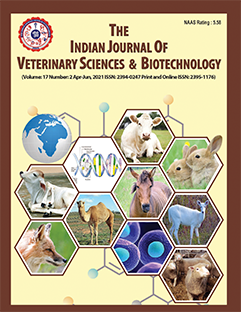Identification, Antimicrobial Sensitivity and Molecular Detection of Staphylococcus aureus and Staphylococcus pseudintermedius Isolated from Ear Infections of Canines
DOI:
https://doi.org/10.48165/ijvsbt.21.5.16Keywords:
Antimicrobial susceptibility, Bacterial isolates, Dogs, Ear infections, PCR, StaphylococcusAbstract
The present study was undertaken to identify by molecular detection and investigate the antimicrobial susceptibility of S. aureus and S. pseudintermedius, which are a major pathogens of public health concern in both animals and human beings. 132 ear swabs were collected from 92 dogs suffering with different types of ear infections. On isolation 85 (70.24%) isolates were identified as Staphylococcus. Through molecular profiling targeting nuc gene 23 isolates were identified as S. aureus, and 26 isolates were identified as S. pseudintermedius. On antimicrobial susceptibility testing S. aureus isolates exhibited greater sensitivity towards cephalothin (78.26%) followed by gentamicin and chloramphenicol (60.86% each), and ciprofloxacin (56.52%). S. pseudintermedius isolates exhibited greater sensitivity towards enrofloxacin (69.23%), followed by cephalothin and amoxiclav (61.53% each), and amikacin (57.69%). PCR studies targeting mecA, tetK, tetM genes revealed that 23 isolates of S. aureus and 26 isolates of S. pseudintermedius were positive for mecA gene. 14 isolates of S. aureus and 17 isolates of S. pseudintermedius were positive for tetK gene. 12 isolates of S. aureus, and 14 isolates of S. pseudintermedius were positive for tetM gene.
Downloads
References
Bannoehr, J., Franco, A., Iurescia, M., Battisti, A., & Fitzgerald, J.R. (2009). Molecular diagnostic identification of Staphylococcus pseudintermedius. Journal of Clinical Microbiology, 47(2), 469-471.
Bourély, C., Cazeau, G., Jarrige, N., Leblond, A., Madec, J.Y., Haenni, M., & Gay, E. (2019). Antimicrobial resistance patterns of bacteria isolated from dogs with otitis. Epidemiology and Infection, 147, 1-10.
Chai, M.H., Sukiman, M.Z., Liew, Y.W., Shapawi, M.S., Roslan, F.S., Hashim, S.N., Mohamad, N.M., Ariffin, S.M., & Ghazali, M.F. (2021). Detection, molecular characterization and antibiogram of multi-drug resistant and methicillin-resistant Staphylococcus aureus (MRSA) isolated from pets and pet owners in Malaysia. Iranian Journal of Veterinary Research, 22(4), 277-287.
Chitra, M.A., Jayanthy, C., & Nagarajan, B. (2015). Detection and sequence analysis of accessory gene regulator genes of Staphylococcus pseudintermedius isolates. Veterinary World, 8(7), 902-907.
Doshi, D.M., Bhanderi, B.B., Mathakiya, R.A., Nimavat, V.R., & Jhala, M.K. (2021). Isolation, characterization, antibiogram and molecular detection of antibiotic resistance genes from bacteria isolated from otitis externa in dogs. The Indian Journal of Veterinary Sciences and Biotechnology, 17(2), 42-47.
Dziva, F., Wint, C., Auguste, T., Heeraman, C., Dacon, C., Yu, P., & Koma, L.M. (2015). First identification of methicillin-resistant Staphylococcus pseudintermedius strains among coagulase positive staphylococci isolated from dogs with otitis externa in Trinidad, West Indies. Infection Ecology and Epidemiology, 28(5), 29170.
Hadi, F.T., & Alabbas, N.N. (2023). Identification of methicillin resistant Staphylococcus aureus (MRSA) isolated from canine otitis externa cases. Journal of Survey in Fisheries Sciences, 10(3), 834-843.
Malik, S., Peng, H., & Barton, M.D. (2006). Partial nucleotide sequencing of the mecA genes of Staphylococcus aureus isolates from cats and dogs. Journal of Clinical Microbiology, 44(2), 413-416.
Matanovic, K., Mekić, S., & Šeol, B. (2012). Antimicrobial susceptibility of Staphylococcus pseudintermedius isolated from dogs and cats in Croatia during a six-month period. Veterinarski Arhiv, 82(5), 505-517.
Morris, D.O., Rook, K.A., Shofer, F.S., & Rankin, S.C. (2006). Screening of Staphylococcus aureus, Staphylococcus intermedius, and Staphylococcus schleiferi isolates obtained from small companion animals for antimicrobial resistance: A retrospective review of 749 isolates (2003–04). Veterinary Dermatology, 17(5), 332-337.
Qekwana, D.N., Oguttu, J.W., & Sithole, F. (2017). Burden and predictors of Staphylococcus aureus and Staphylococcus pseudintermedius infections among dogs presented at an academic veterinary hospital in South Africa (2007–12). Peer Journal, 5, e3198.
Rubin, J.E., Ball, K.R., & Chirino-Trejo, M. (2011). Antimicrobial susceptibility of Staphylococcus aureus and Staphylococcus pseudintermedius isolated from various animals. Canadian Veterinary Journal, 52(2), 153-157.
Ruzauskas, M., Couto, N., Pavilonis, A., Klimiene, I., Siugzdiniene, R., Virgailis, M., Vaskeviciute, L., Anskiene, L., & Pomba, C. (2016). Characterization of Staphylococcus pseudintermedius isolated from diseased dogs in Lithuania. Polish Journal of Veterinary Sciences, 19(1), 7-14.
Sasaki, T., Tsubakishita, S., Tanaka, Y., Sakusabe, A., Ohtsuka, M., Hirotaki, S., Kawakami, T., Fukata, T., & Hiramatsu, K. (2010). Multiplex-PCR method for species identification of coagulase positive staphylococci. Journal of Clinical Microbiology, 48(3), 765-769.
Schmitz, F.J., Krey, A., Sadurski, R., Verhoef, J., Milatovic, D., & Fluit, A.C. (2001). Resistance to tetracycline and distribution of tetracycline resistance genes in European Staphylococcus aureus isolates. Journal of Antimicrobial Chemotherapy, 47(2), 239-240.
Subapriya, S., Senthil, N.R., Vairamuthu, S., Nagarajan, B., Kavitha, S., & George, R.S. (2015). A study on microbial profile and trend in antimicrobial susceptibility of canine otitis. International Journal of Livestock Research, 5(2), 43-48.
Tamilarasu, S., Jayalaskhmi, V., Srinivasan, V.V., Barbuddhe, S.B., Antony, P.X., & Mukhopadhyaya, H.K. (2020). Isolation and molecular characterization of methicillin-resistant Staphylococcus pseudintermedius in dogs. The Indian Journal of Veterinary Sciences and Biotechnology, 15(4), 71-74.
Terziev, G., & Urumova, V. (2018). Retrospective study on the etiology and clinical signs of canine otitis. Comparative Clinical Pathology, 27(1), 7-12.
Yoon, J.W., Lee, K.J., Lee, S.Y., Chae, M.J., Park, J.K., Yoo, J.H., & Park, H.M. (2010). Antibiotic resistance profiles of Staphylococcus pseudintermedius isolates from canine patients in Korea. Journal of Microbiology and Biotechnology, 20(12), 1764-1768.
Downloads
Published
Issue
Section
License
Copyright (c) 2025 Indian Journal of Veterinary Sciences and Biotechnology

This work is licensed under a Creative Commons Attribution-NonCommercial-NoDerivatives 4.0 International License.




